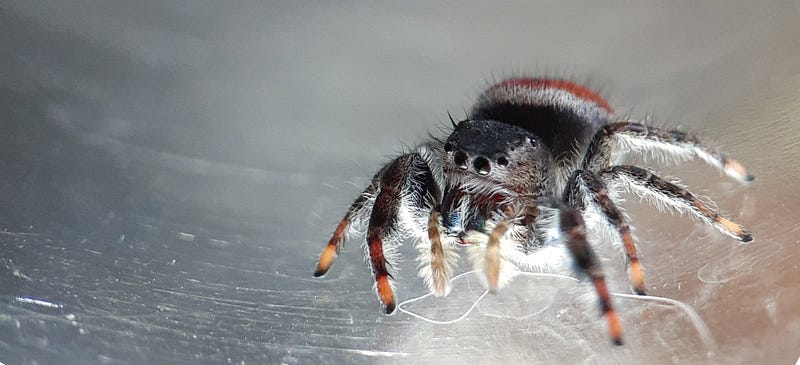Exploring the Fascinating World of Jumping Spiders
Written on
Chapter 1: The Remarkable Nefertiti
It might seem trivial to mourn the passing of a spider, yet how many of us navigated through "Charlotte’s Web" without shedding a tear? Perhaps it's not so silly after all.
Nefertiti the Spidernaut
Recently, I came across the story of Nefertiti, a Phidippus johnsoni, otherwise known as a Red-Backed Jumping Spidernaut. Though her story dates back to 2012, I stumbled upon it while delving into the lives of jumping spiders. Nefertiti, along with her companion Cleopatra, spent an astounding 100 days aboard the International Space Station. While Cleopatra perished upon return to Earth, Nefertiti managed to survive long enough to demonstrate that jumping spiders could adapt their hunting skills in a zero-gravity environment before reverting to their natural behaviors once back on solid ground.

This poignant tale moved me — not only because of the story (which has inspired a picture book) but also due to my fascination with the world around us. The concept of a jumping spider in space contributing to our understanding of their biology and the implications of weightlessness is both mind-boggling and touching. To add to the serendipity, I recently became a caretaker for a Phidippus johnsoni myself.
The Scale of Johnsoni
In the realm of jumping spiders, the johnsoni species is notably large! Over the years, I’ve worked to overcome my fear of spiders, and jumping spiders were the first I felt comfortable holding. Their quirky antics, like attaching silk to my finger before leaping off and swinging back, were endearing. The spider currently residing with me, who remains unnamed for now, is impressively fast and sizable, making it a challenge to capture her in photographs. After two days of persistence, I finally managed to get some images, but I’m hopeful for more once she settles in.

While jumping spiders typically hunt away from their webs, they do create a webbed nest to call home. To my surprise, my johnsoni crafted a web overnight, which I discovered while preparing for another photoshoot before releasing her. Instead, I found myself researching spider habitats and strategizing how to keep fruit flies alive to feed her through the winter months. It’s been quite some time since I was involved in a Drosophila lab, but I still have the skills, even if I lack the necessary equipment.
The Spider Who Couldn't Hide offers a glimpse into the life of these fascinating creatures, showcasing their unique behaviors and adaptations.
Jumping Spiders and Their Charm
With their small stature, prominent eyes, and vibrant personalities, jumping spiders seem to connect with us humans. They exhibit curiosity, often approaching rather than fleeing from people. Unlike their more aggressive counterparts, such as the Carolina Wolf Spider, they maintain a less confrontational demeanor. I recall an incident where my partner found himself in a standoff with a large wolf spider, akin to a scene from a western film. I intervened, knowing that the wolf spider would likely prevail if left unchecked.
The jumping spiders I’ve had the pleasure of photographing are far less daunting, even if my current companion is quite large! I aim to capture a photo of her next to a ruler for scale, so you can truly appreciate her size compared to other species.
For now, I’m focused on refining her enclosure and learning from others who have embraced the world of jumping spiders. Oh, and I must mention her metallic mandibles — my johnsoni, a true New Mexican Jumping Spider, boasts mandibles that mirror the striking blue hues found in Santa Fe's doorways.
~ Tess
Feel free to connect with me on Medium or Facebook, or follow my musings on Twitter, where I share insights on topics ranging from migraines to rural living and the wonders of nature.
ITSY BITSY SPIDER - Song for Children provides a delightful and engaging way for kids to learn about spiders, blending entertainment and education.